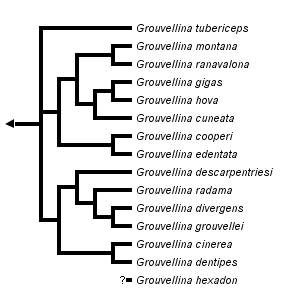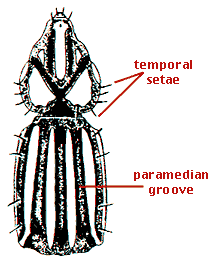Grouvellina
Ross T. Bell


This tree diagram shows the relationships between several groups of organisms.
The root of the current tree connects the organisms featured in this tree to their containing group and the rest of the Tree of Life. The basal branching point in the tree represents the ancestor of the other groups in the tree. This ancestor diversified over time into several descendent subgroups, which are represented as internal nodes and terminal taxa to the right.

You can click on the root to travel down the Tree of Life all the way to the root of all Life, and you can click on the names of descendent subgroups to travel up the Tree of Life all the way to individual species.
For more information on ToL tree formatting, please see Interpreting the Tree or Classification. To learn more about phylogenetic trees, please visit our Phylogenetic Biology pages.
close boxIntroduction
Grouvellina is a genus with 15 species. It is confined to Madagascar and the nearby Comoro Islands, where it is the only group of Rhysodini present.
Characteristics
The eyes and hind wings are fully developed. There are 2-6 temporal setae. The labrum has one or two pairs of setae. The paramedian grooves of the pronotum are present. The antenna-cleaning organ is distad to the base of the tarsus or nearly so. The middle tibia has one spur and medial process. The hind tibia has two spurs in the female, one spur in the male.
References
Bell, R. T. and J. R. Bell. 1979. Rhysodini of the World part II. Revisions of the smaller genera (Coleoptera: Carabidae or Rhysodidae). Quaestiones Entomologicae 15: 377-446.
Title Illustrations

| Scientific Name | Grouvellina gigas |
|---|---|
| Location | Madagascar, Chutes de la Mort |
| Specimen Condition | Dead Specimen |
| Collection | CAS |
| Type | paratype |
| Image Use |
 This media file is licensed under the Creative Commons Attribution License - Version 3.0. This media file is licensed under the Creative Commons Attribution License - Version 3.0.
|
| Copyright |
© 2000 David R. Maddison

|
About This Page
Ross T. Bell

University of Vermont, Burlington, Vermont, USA
Page copyright © 2000 Ross T. Bell
All Rights Reserved.
- First online 01 March 2000
Citing this page:
Bell, Ross T. 2000. Grouvellina. Version 01 March 2000. http://tolweb.org/Grouvellina/1805/2000.03.01 in The Tree of Life Web Project, http://tolweb.org/









 Go to quick links
Go to quick search
Go to navigation for this section of the ToL site
Go to detailed links for the ToL site
Go to quick links
Go to quick search
Go to navigation for this section of the ToL site
Go to detailed links for the ToL site